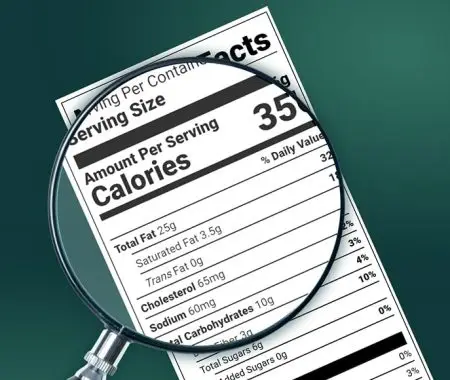Canada’s bilingual packaging requirements ensures that both English and French speakers have equal access to product information. This approach not only respects linguistic rights but makes products accessible to a wider audience. The Canadian Food Inspection Agency (CFIA), alongside the Consumer Packaging and Labelling Act, states that key information on consumer prepackaged goods must be presented in both official languages. This includes product names, net quantity, and any mandatory health, safety, or nutritional information.
For businesses, following these rules helps you enter and operate in the Canadian market smoothly, avoiding legal troubles and the costly risk of having to pull your products off the shelves. Tools like Food Label Maker make compliance simpler by allowing you to create a food label quickly and accurately. You can also view our pricing plans to find the right package for your business needs.
The main aim of these requirements is to ensure that everyone, no matter what language they speak, can understand what they’re buying, building trust and transparency with consumers.
See How FoodLabelMaker Can Help You
TLDR
- Mandatory Bilingual Info: Essential product details like identity, net quantity, and manufacturer info must be in English and French.
- Unilingual Exemptions: Some products may qualify for unilingual labels due to their nature or use, but these exemptions are strictly regulated.
- Legibility and Placement: English and French text must be clear and either side by side or close enough for easy comparison.
- Specialty and Local Foods: Certain local foods may be exempt from bilingual labelling if they are produced and sold only in a local area where less than 10% of the population speaks English or French, as defined in the Food and Drug Regulations (FDR) and SFCR. However, these exemptions are very narrow and test-market foods are not automatically exempt — in most cases, they must still display bilingual information.
- B2B Compliance Challenges: Businesses face hurdles like ensuring accuracy across languages and keeping up with regulations. Tools like Food Label Maker simplify creating compliant labels.
- Net Quantity Declarations: Must be bilingual, using metric units, with words like “grams” needing translation to “grammes” in French.
- Voluntary Information: Certain non-mandatory details, like organic claims or health benefits, also need to be bilingual.
- Provincial Requirements: Quebec has stricter language laws, requiring French to be more prominent. Other provinces may have their own rules.
- Tools for Compliance: Food Label Maker and adherence to the Consumer Packaging and Labelling Act guidelines are key resources for ensuring bilingual label compliance.
Bilingual Labelling Requirements
Mandatory Bilingual Information on Consumer Prepackaged Foods
For consumer-prepackaged foods, bilingual labeling is non-negotiable. Essential details such as the product identity, the product’s net quantity (the product’s weight excluding packaging), and the manufacturer’s name and place of business must be included on the package in both English and French. This requirement ensures that all consumers, irrespective of their linguistic background, have the necessary information to make safe and informed dietary choices.
Specific Exemptions and Conditions for Unilingual Labelling
While the rule is to have labels in both English and French, some products can have labels in just one language due to their specific use or nature. However, these exemptions are tightly regulated, and businesses need to understand these conditions to follow the law correctly. It’s a careful process that might need some expert advice to get right.
In Canada, bilingual packaging is all about valuing different languages to connect with more customers and follow legal requirements. Businesses need to pay close attention to their labels, making sure all the details are clear in both English and French. Tools like Food Label Maker are great for this, making it easier to create labels that fit these bilingual needs perfectly.
Legibility and Location
When it comes to bilingual packaging in Canada, both English and French text must be presented so that consumers can easily read and understand product details. This includes using a minimum font size, providing sufficient contrast between text and background, and avoiding any obstructions from packaging design elements.
Best practices suggest that English and French information should be side by side or close enough that they can be easily compared. For instance, nutritional facts tables should present English and French in parallel columns, allowing consumers to effortlessly access information in their preferred language. This approach not only aids in consumer understanding but underscores the equal importance of both languages.
Exemptions and Special Cases
Specialty, Local, and Test Market Foods
Certain niche categories may be exempt from standard bilingual labeling requirements. These include:
- Specialty food used in religious practices (not Kosher or Halaal food) or imported products
- Local foods that are produced, processed, or packaged within a specific area and sold only within that area or its adjacent locations, provided the primary language of less than 10% of the local population is English or French.
- Products introduced in test markets
As an example, a locally produced honey sold exclusively at a regional farmers’ market might not need full bilingual labeling. However, these exemptions are specific and limited, often requiring approval or notification to the CFIA.
Bilingual Labelling Exemptions
While the general rule mandates bilingual labels, there are nuanced exemptions under certain conditions. Products such as single-ingredient items (e.g., a bag of sugar) might not require full bilingual labeling. However, it’s imperative for businesses to consult the latest CFIA guidelines or seek expert advice to understand if their product qualifies for any exemptions.
B2B Compliance Challenges
Navigating bilingual labeling requirements presents a unique set of challenges for B2B enterprises, especially those new to the Canadian market or expanding their product lines. Common pain points include ensuring accuracy and consistency across languages, meeting legibility standards, and keeping up with regulatory changes.
In response to these challenges, software solutions like Food Label Maker have emerged as invaluable tools. These platforms streamline the creation of compliant labels, offering features like bilingual templates, automatic updates for new regulations, and options to customize for specific product needs. By using such technology, businesses can significantly reduce the risk of errors and make the process of making labels much quicker and smoother.
The consequences of non-compliance with bilingual labeling requirements can be severe, ranging from product recalls and fines to reputational damage. Non-compliance not only signifies a breach of regulations but can also imply a disregard for Canada’s linguistic diversity and potentially alienate a significant portion of the consumer base.
Bilingual Requirements for Net Quantity Declarations
In Canada, the net quantity of a product must be declared in both English and French as a regulatory requirement. This ensures that all consumers, regardless of their preferred official language, can understand exactly what they’re getting. The net quantity must be clearly stated, typically in metric units for weight, volume, or count, and must be equally legible in both languages. If words are used instead of SI (International System of Units) symbols for net quantities, they need to be in both languages, so “grams” in English and “grammes” in French. It’s also recommended to have phrases like “net weight” in both English and French as well.
Accuracy in bilingual declarations extends beyond mere translation. It involves presenting measurements and counts in a format that is universally understood, adhering to the metric system as per Canadian regulations. For instance, weight should be declared in grams or kilograms, and volume in milliliters or liters, with the corresponding English and French terms used consistently to prevent any confusion.
Bilingual Labelling of Voluntary Information
Certain voluntary information must be bilingual, including:
- Organic claims: “organic” in English must also appear as “biologique” in French.
- Nutrient content claims: Claims such as “Low in sodium” in English must also be stated as “Faible en sodium” in French.
- Additional Nutrition Facts: Optional nutrients listed must be in both languages.
- Health claims: Claims such as “Does not promote tooth decay” in English need a French version.
Businesses should stay informed about specific guidelines that dictate when and how voluntary information should be bilingual, ensuring compliance and clarity.
Additional Provincial Requirements
Quebec, with its predominantly French-speaking population, has additional stipulations under the Charter of the French Language. It requires French to be more prominent on multilingual packaging and all instructions to be in French. This doesn’t negate the need for English but emphasizes the importance of French in the Quebec market. Businesses operating in or distributing to Quebec must be particularly diligent in adhering to these standards. For marketing efforts in Quebec, ensure your advertisements are not just translated but also culturally adapted to connect with this discerning audience.
Beyond Quebec, other Canadian provinces may have their nuances in bilingual labeling requirements, influenced by regional demographics and consumer expectations. Companies must be adaptable, tailoring their labeling practices to meet federal standards and respect provincial regulations. This might involve consulting local regulatory bodies or legal experts to ensure all packaging and labeling are fully compliant and respectful of Canada’s linguistic diversity.
Tools and Resources for Ensuring Compliance
Navigating the complexities of bilingual packaging and labeling in Canada can be daunting. Fortunately, a range of tools and resources are available to help businesses ensure their products meet the stringent requirements set forth by Canadian regulations.
Food Label Maker stands out as an indispensable tool for businesses looking to streamline their compliance process. This innovative software simplifies the creation of bilingual labels, ensuring that all mandatory information, including net quantity, ingredients, and nutritional facts, is accurately presented in both English and French. With customizable templates and real-time updates to reflect the latest regulatory changes, Food Label Maker empowers businesses to maintain compliance with confidence and ease. You can get started by creating a food label using our free tool or viewing our pricing plans to find the ideal package for your business needs.
The Consumer Packaging and Labelling Act also provides a comprehensive framework for businesses, ensuring their packaging and labeling practices are up to standard. By closely adhering to the guidelines set out in this act, businesses can avoid common pitfalls associated with bilingual labeling. The act covers everything from the placement and prominence of bilingual information to the specifics of net quantity declarations, offering a clear path to compliance. Businesses are encouraged to consult these guidelines regularly, as well as any updates or clarifications provided by the Canadian Food Inspection Agency (CFIA), to stay informed and compliant.



